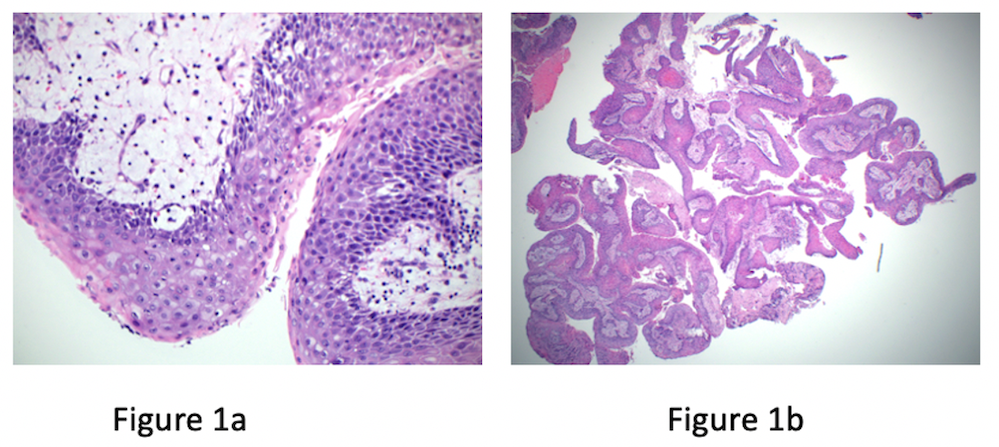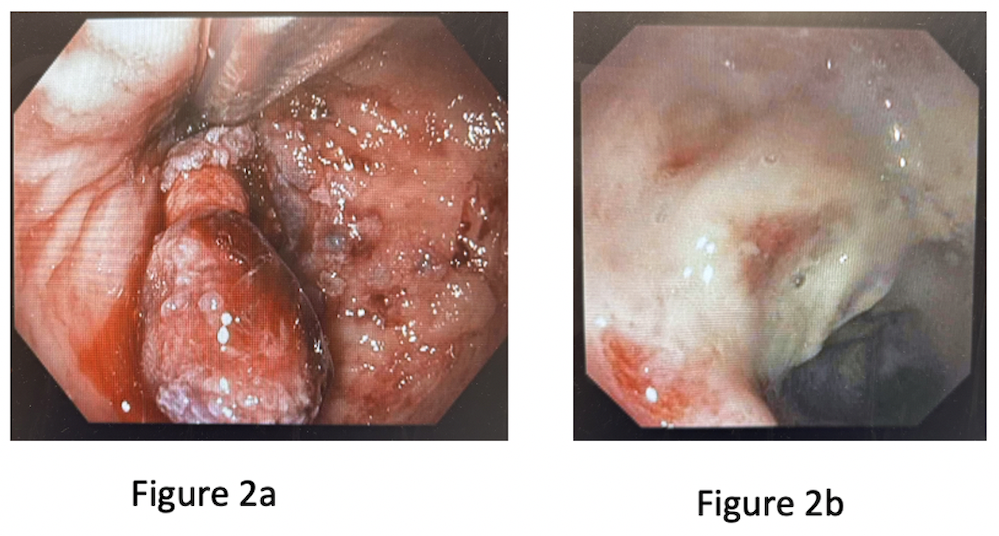Monday Poster Session
Category: Esophagus
P2821 - The Diagnosis and Management of a Rare Case of Dysphagia: Esophageal Squamous Papillomatosis
Monday, October 27, 2025
10:30 AM - 4:00 PM PDT
Location: Exhibit Hall
- AZ
Angelika Zalewski, MD
University of Minnesota Medical School
Minneapolis, MN
Presenting Author(s)
Angelika Zalewski, MD1, Megan B.. Ghai, MD, MPH, MA1, Stephanie H. Rodriguez, MD2, Nirjhar Dutta, DO, MS1, Justin Peltola, MD3, Brian Hanson, MD3
1University of Minnesota Medical School, Minneapolis, MN; 2University of Minnesota, Minneapolis, MN; 3University of Minnesota and Minneapolis VA Health Care System, Minneapolis, MN
Introduction: Esophageal papillomas (EP) are rare and benign solitary lesions of squamous tissue incidentally found in the esophagus. EP is not fully understood, but postulated risk factors include chronic mucosal disruption, human papilloma virus, and mechanical injury. Diffuse or extensive EP, called esophageal squamous papillomatosis (ESP), is considered exceedingly rare and to our knowledge only 53 cases have been reported. Presented here is a severe case of ESP managed with endoscopic liquid nitrogen spray cryotherapy and serial dilation.
Case Description/
Methods: A 70-year-old male with longstanding dysphagia presented to the Veterans Affairs Medical Center for worsening dysphagia. Initial esophagogastroduodenoscopy (EGD) revealed a 6 mm distal esophageal stricture with friable mucosa. Despite proton pump inhibitor (PPI) compliance, follow-up EGDs continued to demonstrate an intrinsic stricture. Two months later, an esophageal mass-like area within the proximal esophagus was noted. Pathology results confirmed ESP without dysplasia or malignancy (figures 1a and 1b).
Intermittent endoscopic liquid nitrogen spray cryotherapy with dilation was performed. However, later that year the patient presented to the hospital with severe malnutrition and failure to thrive. EGD revealed ESP proliferation with a near total occlusion of the esophagus including a “ball valving” component of pedunculated tissue (figure 2a). Enteral feeding was initiated but persistent malnutrition and comorbidities precluded esophagectomy. It was then decided to perform spray cryotherapy with dilation every 7-10 days over the course of 6 weeks. This treatment resulted in a near absence of ESP and improvement in inner diameter to 15 mm (figure 2b). The patient was able to tolerate a soft diet for the first time in 3 years.
Discussion: This case underscores the therapeutic potential of cryotherapy in ESP, an entity with an unclear natural history and no formalized treatment guidelines. While esophagectomy is curative, comorbidities precluded surgery for this patient. Cryotherapy in this case achieved increased luminal diameter allowing for oral intake, whereas dilation or PPI therapy alone had not. It is yet to be determined how effective cryotherapy is in the treatment of ESP over time but this case adds to the limited literature supporting cryotherapy as a viable intervention in severe ESP.

Figure: Figure 1a: High power field hematoxylin and eosin staining of the mid-esophageal stricture demonstrating finger-like projections with a fibrovascular core covered by acanthotic squamous epithelium characteristic of esophageal squamous papillomatosis.
Figure 1b: Low power field hematoxylin and eosin staining of mid-esophageal stricture confirming esophageal squamous papillomatosis.

Figure: Figure 2a: Prior to initiating serial cryotherapy and dilation treatments: Esophagogastroduodenoscopy image showing bulky esophageal squamous papillomatosis causing near total occlusion of the esophagus with a “ball valve” component.
Figure 2b: After initiating serial cryotherapy and dilation treatments: Esophagogastroduodenoscopy image showing near resolution of esophageal squamous papillomatosis.
Disclosures:
Angelika Zalewski indicated no relevant financial relationships.
Megan Ghai indicated no relevant financial relationships.
Stephanie Rodriguez indicated no relevant financial relationships.
Nirjhar Dutta indicated no relevant financial relationships.
Justin Peltola indicated no relevant financial relationships.
Brian Hanson indicated no relevant financial relationships.
Angelika Zalewski, MD1, Megan B.. Ghai, MD, MPH, MA1, Stephanie H. Rodriguez, MD2, Nirjhar Dutta, DO, MS1, Justin Peltola, MD3, Brian Hanson, MD3. P2821 - The Diagnosis and Management of a Rare Case of Dysphagia: Esophageal Squamous Papillomatosis, ACG 2025 Annual Scientific Meeting Abstracts. Phoenix, AZ: American College of Gastroenterology.
1University of Minnesota Medical School, Minneapolis, MN; 2University of Minnesota, Minneapolis, MN; 3University of Minnesota and Minneapolis VA Health Care System, Minneapolis, MN
Introduction: Esophageal papillomas (EP) are rare and benign solitary lesions of squamous tissue incidentally found in the esophagus. EP is not fully understood, but postulated risk factors include chronic mucosal disruption, human papilloma virus, and mechanical injury. Diffuse or extensive EP, called esophageal squamous papillomatosis (ESP), is considered exceedingly rare and to our knowledge only 53 cases have been reported. Presented here is a severe case of ESP managed with endoscopic liquid nitrogen spray cryotherapy and serial dilation.
Case Description/
Methods: A 70-year-old male with longstanding dysphagia presented to the Veterans Affairs Medical Center for worsening dysphagia. Initial esophagogastroduodenoscopy (EGD) revealed a 6 mm distal esophageal stricture with friable mucosa. Despite proton pump inhibitor (PPI) compliance, follow-up EGDs continued to demonstrate an intrinsic stricture. Two months later, an esophageal mass-like area within the proximal esophagus was noted. Pathology results confirmed ESP without dysplasia or malignancy (figures 1a and 1b).
Intermittent endoscopic liquid nitrogen spray cryotherapy with dilation was performed. However, later that year the patient presented to the hospital with severe malnutrition and failure to thrive. EGD revealed ESP proliferation with a near total occlusion of the esophagus including a “ball valving” component of pedunculated tissue (figure 2a). Enteral feeding was initiated but persistent malnutrition and comorbidities precluded esophagectomy. It was then decided to perform spray cryotherapy with dilation every 7-10 days over the course of 6 weeks. This treatment resulted in a near absence of ESP and improvement in inner diameter to 15 mm (figure 2b). The patient was able to tolerate a soft diet for the first time in 3 years.
Discussion: This case underscores the therapeutic potential of cryotherapy in ESP, an entity with an unclear natural history and no formalized treatment guidelines. While esophagectomy is curative, comorbidities precluded surgery for this patient. Cryotherapy in this case achieved increased luminal diameter allowing for oral intake, whereas dilation or PPI therapy alone had not. It is yet to be determined how effective cryotherapy is in the treatment of ESP over time but this case adds to the limited literature supporting cryotherapy as a viable intervention in severe ESP.

Figure: Figure 1a: High power field hematoxylin and eosin staining of the mid-esophageal stricture demonstrating finger-like projections with a fibrovascular core covered by acanthotic squamous epithelium characteristic of esophageal squamous papillomatosis.
Figure 1b: Low power field hematoxylin and eosin staining of mid-esophageal stricture confirming esophageal squamous papillomatosis.

Figure: Figure 2a: Prior to initiating serial cryotherapy and dilation treatments: Esophagogastroduodenoscopy image showing bulky esophageal squamous papillomatosis causing near total occlusion of the esophagus with a “ball valve” component.
Figure 2b: After initiating serial cryotherapy and dilation treatments: Esophagogastroduodenoscopy image showing near resolution of esophageal squamous papillomatosis.
Disclosures:
Angelika Zalewski indicated no relevant financial relationships.
Megan Ghai indicated no relevant financial relationships.
Stephanie Rodriguez indicated no relevant financial relationships.
Nirjhar Dutta indicated no relevant financial relationships.
Justin Peltola indicated no relevant financial relationships.
Brian Hanson indicated no relevant financial relationships.
Angelika Zalewski, MD1, Megan B.. Ghai, MD, MPH, MA1, Stephanie H. Rodriguez, MD2, Nirjhar Dutta, DO, MS1, Justin Peltola, MD3, Brian Hanson, MD3. P2821 - The Diagnosis and Management of a Rare Case of Dysphagia: Esophageal Squamous Papillomatosis, ACG 2025 Annual Scientific Meeting Abstracts. Phoenix, AZ: American College of Gastroenterology.
